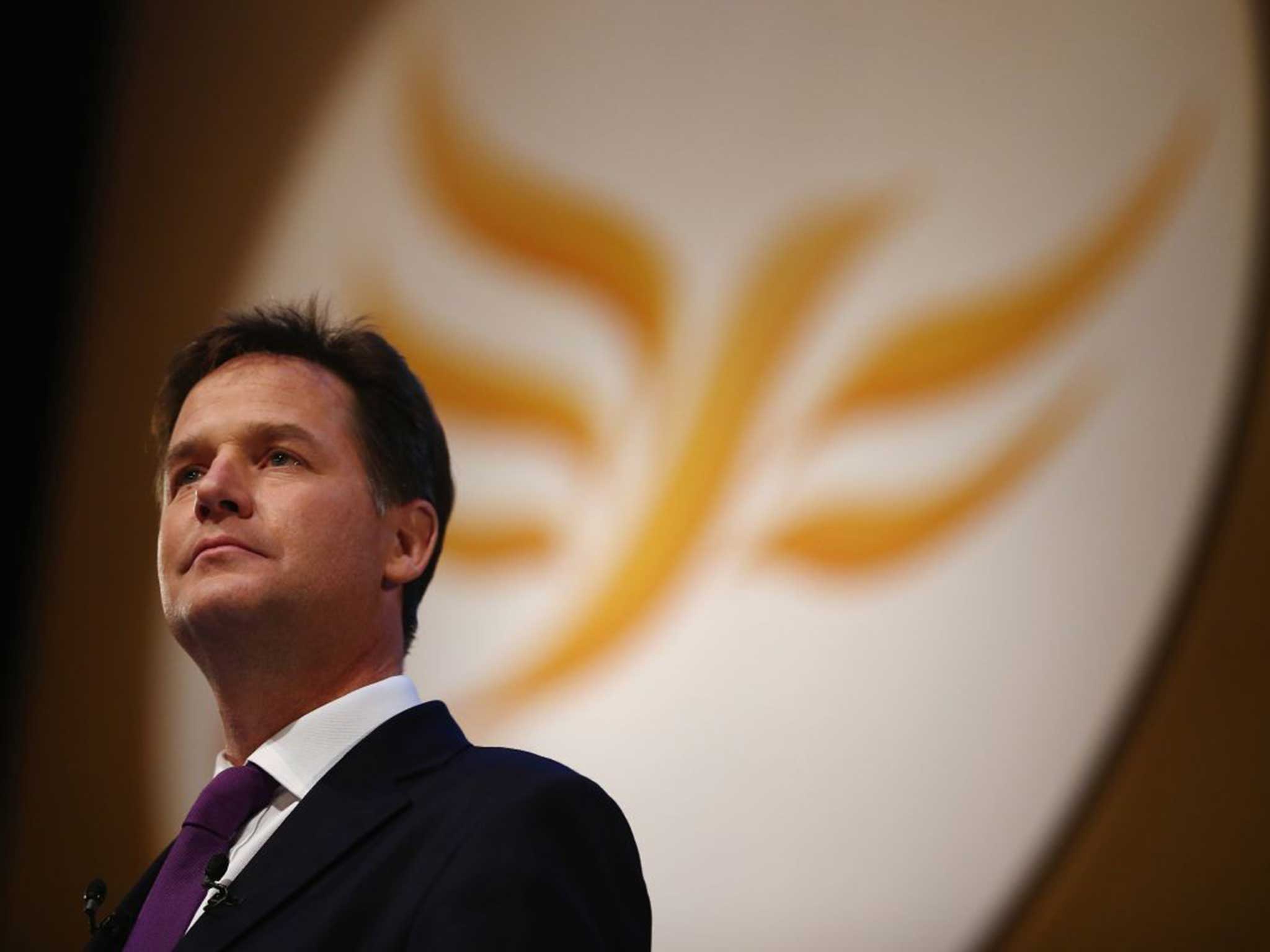The outcome of the election will be decided by a tug of war to claim disaffected Lib Dem voters
There is a group of 1.3 million floating voters out there


Your support helps us to tell the story
From reproductive rights to climate change to Big Tech, The Independent is on the ground when the story is developing. Whether it's investigating the financials of Elon Musk's pro-Trump PAC or producing our latest documentary, 'The A Word', which shines a light on the American women fighting for reproductive rights, we know how important it is to parse out the facts from the messaging.
At such a critical moment in US history, we need reporters on the ground. Your donation allows us to keep sending journalists to speak to both sides of the story.
The Independent is trusted by Americans across the entire political spectrum. And unlike many other quality news outlets, we choose not to lock Americans out of our reporting and analysis with paywalls. We believe quality journalism should be available to everyone, paid for by those who can afford it.
Your support makes all the difference.At first glance, David Cameron’s reshuffle was about appealing to women voters and luring back Conservatives who have defected to Ukip.
The Eurosceptics Philip Hammond and Michael Fallon, who are prepared to see Britain quit the EU, were promoted, while opponents of leaving the European Convention on Human Rights, such as Kenneth Clarke and Dominic Grieve, were thrown overboard.
Yet the Cabinet makeover was also aimed at a group which have quietly emerged as the most crucial segment of voters at next year’s general election: the 6.8 million who backed the Liberal Democrats in 2010.
The Tories and Labour are taking a very close interest in them, because of those 6.8 million only 38 per cent of people now saying how they will vote next May intend to stick with Nick Clegg’s party.
According to a ComRes study, based on its polls for this newspaper this year, 28 per cent of that group intend to vote Labour, 10 per cent Conservative, 10 per cent Green, 8 per cent Ukip and 5 per cent for another party, other than the Lib Dems.
Crucially, one in five Lib Dem voters from 2010 (19 per cent) is undecided: that’s twice as many “don’t knows” as there are among those who voted Tory or Labour in 2010. So there is a group of 1.3 million floating voters out there. “They will decide the election,” said one Labour strategist.
On the face of it, the Lib Dem collapse should be good news for Ed Miliband. The biggest shift in the polls since the last election was the transfer of a big slice of Lib Dem voters to Labour as soon as Mr Clegg joined forces with Mr Cameron.
The bad news for Labour is that some of the 2010 Lib Dems have since drifted away from Mr Miliband’s party. In the first half of last year, 32 per cent of the ex-Lib Dems intended to vote Labour. By this year, the figure had dropped to 28 per cent. This helps to explain Labour’s narrowing poll lead over the Tories. It also explains why Labour demonises the Lib Dems as “Tory accomplices” and will not raise the prospect of coalition with them in another hung parliament, as this could give their defectors permission to return home.
Labour cannot take the former Lib Dem voters for granted. It needs to earn their support. How? Watch out for a dramatic pledge to cut Mr Clegg’s £9,000-a-year university tuition fees at Labour’s September conference. Neat.
This week showed that Labour has plenty of competition for the Lib Dem deserters. The brutal ousting of Michael Gove, one of Mr Cameron’s closest friends and political allies, showed that the Prime Minister will remove any obstacle on his path to victory next year.
Mr Gove was so unpopular among teachers and parents that he had become, in the words of Lynton Crosby, the Tories’ Aussie election strategist, a “barnacle on the bottom of the boat”. So he was scraped off and demoted to Chief Whip.
The more emollient Nicky Morgan will try to rebuild bridges with public sector workers. Some will have voted Lib Dem last time; the party has traditionally had a following among teachers.
The leader who most needs the Lib Dem 2010 supporters is, of course, Mr Clegg. His call for fundamental reform of the so-called “bedroom tax” was pitched at voters who think the Lib Dems sold their soul by supping with the Tory devil.
Yet the Deputy Prime Minister’s own ratings among his party’s lost voters are dire. Almost half (45 per cent) have an unfavourable view of him, while only one in four is favourable towards him, indicating a much more widespread hostility than the 2010 Labour and Tory voters feel towards their party’s current leader.
However, all is not lost for the Lib Dems. The mood of the electorate is very fluid, and the stranglehold of the big two parties has been broken. The Lib Dems have not given up hope of winning back some defectors. The biggest exodus happened when the Coalition was formed, not when Mr Clegg broke his promise on tuition fees.
The Lib Dem strategy is to persuade former supporters to give the party “a second look”. Lib Dem polling suggests about half of the party’s lost voters have not closed the door to backing it next May.
Mr Clegg’s party is also targeting “soft Cons” who didn’t vote Lib Dem last time but might be winnable next time. They calculate that, despite the party’s coalition trials, 25 to 30 per cent of the electorate are potential Lib Dem voters next May.
The Lib Dems know their biggest challenge is that many voters have little idea what Team Clegg has achieved inside the Coalition. Even recognition of the party’s flagship £10,000-a-year personal tax allowance is far from universal. So the Lib Dems have to tell their target audience what they have won since 2010, why they need to stay in power to ensure “fair austerity” when post-election spending cuts are made and what they have stopped the nasty party from doing.
Whatever happens in a very tight election next year, it won’t, as was claimed in 1992, be “The Sun what won it”. But we might well look back and say it was the Lib Dem 2010 voters who swung it.
Fast-forward 20 years, and Blair has still to move on
You can’t keep Tony Blair out if it. Yesterday’s newspapers had two “Blair stories” – his involvement in the treatment of “on the run” terrorists in Northern Ireland and the latest episode in the saga of the Chilcot inquiry into the Iraq war. And the crisis in Gaza keeps the Middle East envoy on our television screens.
On Monday, Blair will make a speech marking the 20th anniversary of his election as Labour leader. He will deliver the inaugural annual Philip Gould lecture to the Progress pressure group, in memory of the much-loved pollster who played a key role in creating New Labour, who died in 2011.
Friends expect Blair to defend New Labour – no surprise there – and not to criticise Ed Miliband.
But his words will doubtless be pored over for evidence of coded criticism. Blair may not be amused that Miliband is making a speech today saying that the party has “moved on” from New Labour.
The former PM shouldn’tbe too upset, though. Even his Progress hosts, once cheerleaders for Blair, have dropped the “New Labour” label.
Time for everyone to move on, surely.
Join our commenting forum
Join thought-provoking conversations, follow other Independent readers and see their replies
Comments